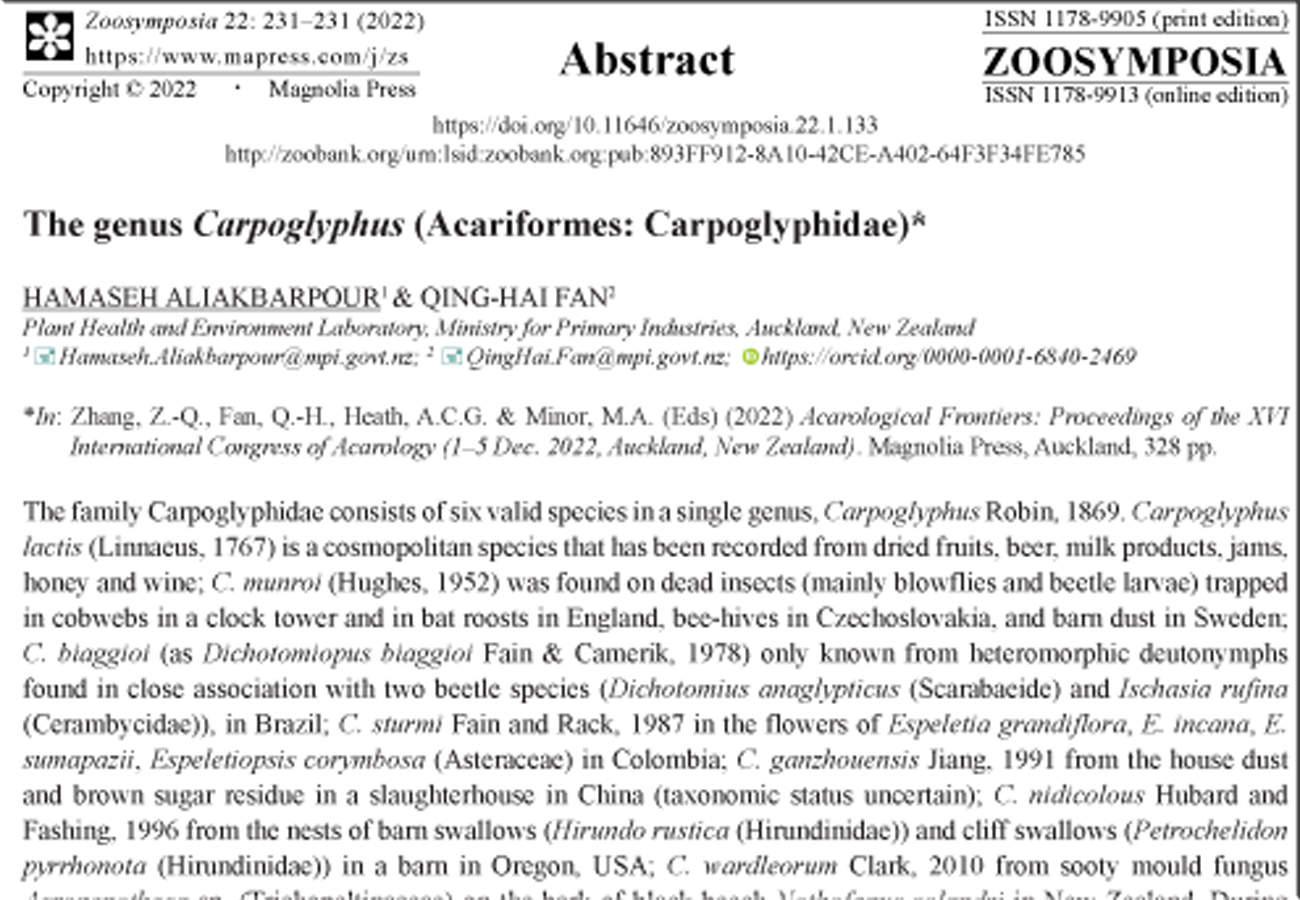Abstract
The family Carpoglyphidae consists of six valid species in a single genus, Carpoglyphus Robin, 1869. Carpoglyphus lactis (Linnaeus, 1767) is a cosmopolitan species that has been recorded from dried fruits, beer, milk products, jams, honey and wine; C. munroi (Hughes, 1952) was found on dead insects (mainly blowflies and beetle larvae) trapped in cobwebs in a clock tower and in bat roosts in England, bee-hives in Czechoslovakia, and barn dust in Sweden; C. biaggioi (as Dichotomiopus biaggioi Fain & Camerik, 1978) only known from heteromorphic deutonymphs found in close association with two beetle species (Dichotomius anaglypticus (Scarabaeide) and Ischasia rufina (Cerambycidae)), in Brazil; C. sturmi Fain and Rack, 1987 in the flowers of Espeletia grandiflora, E. incana, E. sumapazii, Espeletiopsis corymbosa (Asteraceae) in Colombia; C. ganzhouensis Jiang, 1991 from the house dust and brown sugar residue in a slaughterhouse in China (taxonomic status uncertain); C. nidicolous Hubard and Fashing, 1996 from the nests of barn swallows (Hirundo rustica (Hirundinidae)) and cliff swallows (Petrochelidon pyrrhonota (Hirundinidae)) in a barn in Oregon, USA; C. wardleorum Clark, 2010 from sooty mould fungus Acrogenotheca sp. (Trichopeltinaceae) on the bark of black beech Nothofagus solandri in New Zealand. During a high-risk site surveillance at Kibimie, Wellington, New Zealand (accession number: T16_01895), we found an undescribed species from Cordyline kaspar (cabbage tree) infested with Balanococcus cordylinidis (Hemiptera: Pseudococcidae) and Tyrophagus curvipenis (Acari: Acariae). We compare the morphological characteristics of the new species with known species and provide a key to the species of Carpoglyphidae.
References
Clark, J.M. (2010) A new species of Carpoglyphus from the bark of black beech honeydew from New Zealand. International Journal of Acarology, 36(5), 453–459. https://doi.org/10.1080/01647954.2010.493166
Fain, A. & Rack, G. (1987) Notes on the mites living in the flowers of Espeletia spp. (Asteraceae) in Colombia. I. Carpoglyphus sturmi sp. n. (Acari: Carpoglyphidae). Entomologische Mitteilungen aus dem Zoologischen Staatsinstitut und Zoologischen Museum Hamburg, 9, 9–19.
Haragsim, O., Samšiňák, K. & Vobrázková, E.(1978) The mites inhabiting the bee hives in ČSR. Zeitschrift für Angewandte Entomologie, 87, 52–67.
Hubard, C.N. & Fashing, N.J. (1996) Carpoglyphus nidicolous – a new species of carpoglyphidae (Acarina: Astigmata) inhabiting the nests of swallows. International Journal of Acarology, 22(3), 215–220.
Hughes, A.M. (1952) A new glycyphagid mite—Carpoglyphus munroi. Zoological Journal of the Linnean Society, 42(284), 168–175. https://doi.org/10.1111/j.1096-3642.1952.tb01856.x
Hughes, A.M. (1976) The Mites of Stored Food and Houses. 2nd edition. London: Her Majesty’s Stationery Office, 400 pp.
Jiang, Z. (1991) A new species of Carpoglyphidae from China (Acarina: Acaroidea). Journal of Jiangxi University (Natural Science), 15(1), 82–86.


